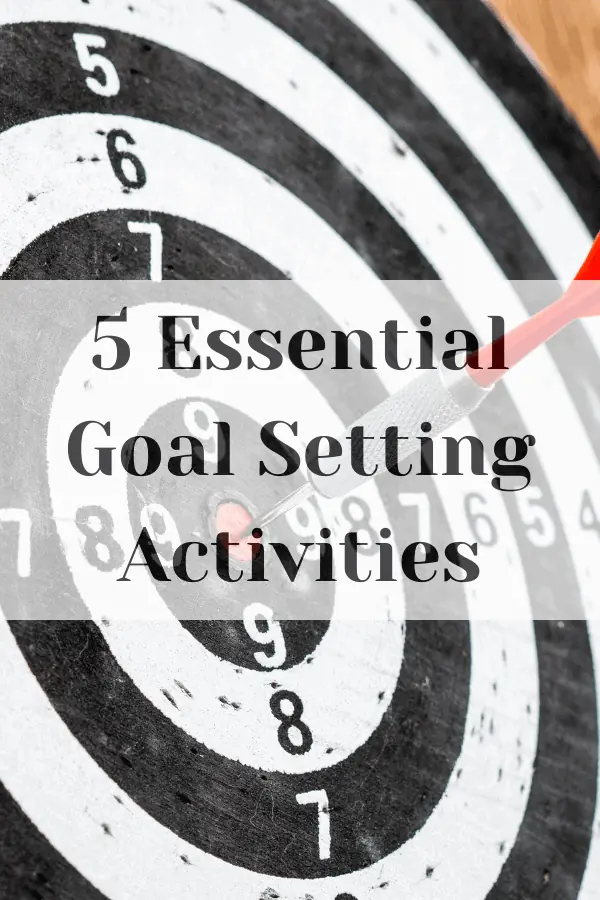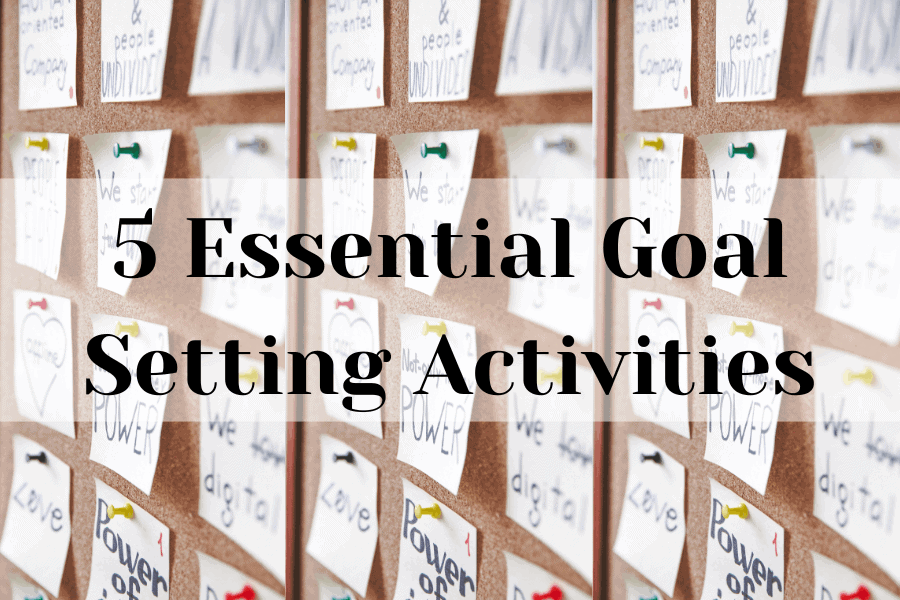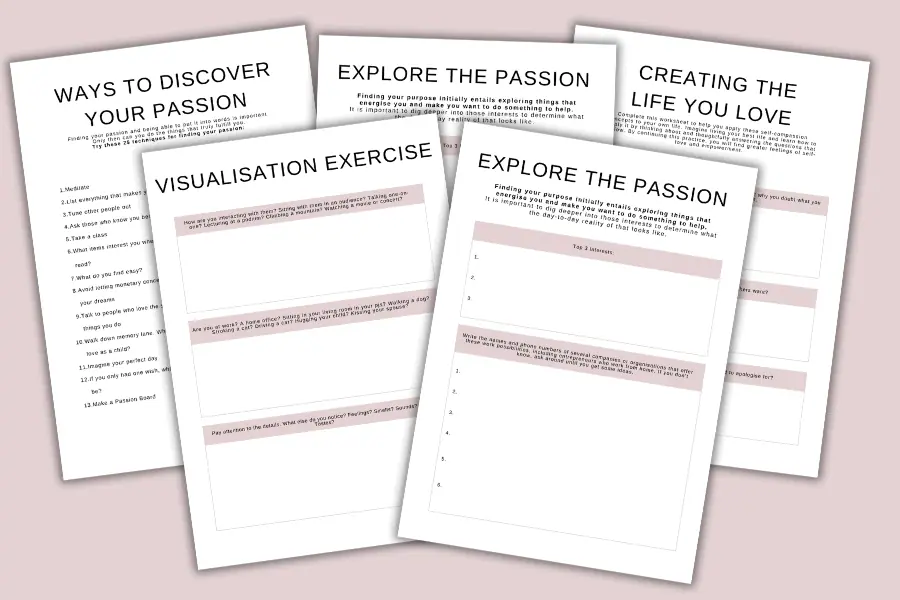5 Essential Goal Setting Activities

In the hustle and bustle of everyday life, it’s easy to get swept away by the currents of routine, leaving our dreams and aspirations adrift. This is where goal-setting activities come into play, offering a compass to steer us towards our desired destinations.
Whether your aim is to scale professional heights, lead a healthier lifestyle, or nurture meaningful relationships, goal-setting activities are the blueprint to manifest those aspirations into reality. They transform abstract dreams into tangible, achievable milestones.
This blog post is about goal setting activities

Understanding Goals
Goals are the guiding stars that illuminate our path towards personal growth and fulfillment. Simply put, they are the specific objectives or outcomes we aspire to achieve. Whether they’re related to our careers, health, relationships, or personal development, goals give us direction and purpose.
In the realm of personal development, goals act as catalysts for transformation. They serve as a framework, allowing us to envision the life we desire and set a clear course towards it. Without goals, we risk drifting along without a sense of direction, allowing opportunities for growth to slip through our fingers.
Now, let’s talk about clarity, specificity, and measurability—three essential elements that give goals their power.
Clarity
Imagine standing in a dense fog, unable to see more than a few steps ahead. Without a clear view of our destination, we’re left stumbling in uncertainty. Similarly, unclear goals lead to confusion and aimlessness. A well-defined goal, on the other hand, paints a vivid picture of what success looks like.
Specificity
Specific goals provide a roadmap, detailing exactly what needs to be achieved. They define the ‘what’, ‘why’, and ‘how’ of our aspirations. For instance, instead of a vague goal like “improve fitness”, a specific goal would be “run a 5k race in under 30 minutes by December”.
Measurability
Goals should be measurable to track progress effectively. They enable us to quantify our achievements, providing a tangible sense of accomplishment. This measurement could be in terms of time, quantity, or any relevant metric. It’s akin to marking milestones along a journey, allowing us to celebrate our progress.
By infusing our goals with clarity, specificity, and measurability, we transform them from abstract dreams into actionable targets. They become tangible, motivating us to take consistent steps towards their realisation.
Goal Setting Activities
Visualisation exercises
Visualisation is a powerful tool that can bring your goals to life, making them feel more real and attainable. Here are some techniques to enhance your visualisation practice:
Immersive Detailing: Close your eyes and vividly imagine achieving your goal. Engage all your senses. What does success look like, feel like, sound like? The more detailed, the more tangible it becomes.
Emotional Connection: Feel the emotions associated with achieving your goal. Whether it’s pride, joy, or a sense of accomplishment, let these emotions wash over you.
Regular Practice: Set aside a few minutes each day to engage in this visualisation exercise. Consistency reinforces your belief in the attainability of your goals.
Benefits of visualisation:
Heightened Motivation: Visualisation ignites a fire within, fueling your determination and motivation to take action towards your goals.
Increased Confidence: Seeing yourself succeed in your mind’s eye builds confidence. It erases doubts and strengthens your belief in your capabilities.
Improved Focus: It sharpens your focus on what needs to be done to reach your goal. You become more attuned to opportunities and actions that align with your vision.
Mind mapping
Mind maps are a powerful tool for organising and clarifying your goals. They provide a visual representation of your aspirations. Here’s how you can create a goal-focused mind map:
Central Goal: Start with your main goal at the centre of the page. This acts as the focal point.
Branch Out: Create branches radiating from the central goal. Each branch represents a different aspect or milestone related to your goal.
Details and Sub-Goals: Add details, tasks, and sub-goals to each branch. This breaks down the larger goal into manageable steps.
Connections: Draw lines connecting related elements. This shows the relationships between different components of your goal.
Benefits of mind mapping
Clarity and Organisation: Mind maps provide a clear visual representation of your goals, making them easier to understand and work towards.
Enhanced Creativity: The visual nature of mind mapping stimulates creative thinking, helping you explore different approaches to achieving your goal.
Effective Planning: By breaking down your goal into smaller, actionable steps, you create a structured plan for success.
Journaling for goal success
Journaling is a powerful practice for tracking progress and staying motivated on your goal-setting journey. Here’s how you can effectively incorporate journaling into your routine:
Regular Entries: Dedicate a specific time each day or week to journal about your goals and progress.
Reflect and Evaluate: Write about your achievements, challenges, and lessons learned. Reflect on what’s working and what needs adjustment.
Set Milestones: Use your journal to set and track milestones towards your larger goals.
Express Gratitude: Take a moment to acknowledge the progress you’ve made, no matter how small. Gratitude reinforces a positive mindset.
Benefits of journaling:
Clear Record of Progress: It provides a tangible record of your journey, showing how far you’ve come and what you’ve accomplished.
Boosts Motivation: Reading about your achievements and progress can be incredibly motivating, especially during challenging times.
Enhanced Self-awareness: Journaling encourages introspection, helping you understand your strengths, weaknesses, and patterns of behaviour.
Accountability partnerships
Having an accountability partner is a game-changer in goal-setting. Here’s how you can find and establish a successful accountability partnership:
Choose the Right Partner: Look for someone who shares similar values, understands your goals, and is committed to supporting you.
Set Clear Expectations: Discuss what accountability looks like for both of you. Establish regular check-ins and communication channels.
Honesty and Transparency: Be open about your progress, challenges, and setbacks. Accountability works best when both parties are honest.
Celebrate Achievements: Acknowledge and celebrate each other’s successes. This reinforces a positive and supportive dynamic.
Benefits of accountability partnerships
Increased Commitment: Knowing that someone is holding you accountable can provide an extra push to stay committed to your goals.
Fresh Perspectives: Your partner can offer valuable insights, ideas, and perspectives that you might not have considered on your own.
Emotional Support: They can provide encouragement and motivation during challenging times, helping you stay on track.
Prioritisation techniques
Effectively prioritising your goals ensures that you focus your time and energy on what truly matters. Here are some methods to help you prioritise your goals:
Eisenhower Matrix: Categorise your goals into four quadrants – urgent and important, important but not urgent, urgent but not important, neither urgent nor important. This helps you identify priorities.
Value-Based Prioritisation: Align your goals with your core values. This ensures that you’re working towards what truly matters to you.
Time Blocking: Allocate specific time slots in your schedule for working on each goal. This helps prevent distractions and ensures dedicated focus.
S.M.A.R.T. Prioritisation: Evaluate your goals based on the SMART criteria. Prioritise goals that are Specific, Measurable, Achievable, Relevant, and Time-bound.
Tools and Strategies for Prioritisation:
Task Management Apps: Utilise digital tools like Trello, Asana, or Todoist to create task lists and set priorities.
Pareto Principle (80/20 Rule): Focus on the 20% of tasks that yield 80% of the results. This principle helps you identify high-impact activities.
Regular Review and Adjustments: Continuously evaluate and adjust your priorities based on changing circumstances and progress.
Key Takeaways
Now that you’ve gained valuable insights into these goal-setting activities, the next step is action. Here’s a friendly nudge to implement these strategies in your life:
Start Small, Dream Big: Begin with one goal-setting activity that resonates with you. Start small and gradually incorporate more as you become comfortable.
Consistency is Key: Consistent practice is the secret sauce. Whether it’s daily journaling or regular accountability check-ins, keep the momentum going.
Embrace Imperfection: Remember that setbacks and challenges are part of the journey. They don’t define your path but rather offer opportunities for growth.
Celebrate Every Step: Acknowledge your progress, no matter how small. Each step forward is a victory in itself. Celebrate your achievements along the way.
Stay Inspired: Surround yourself with inspiration. Read success stories, listen to motivational talks, and connect with a community of like-minded individuals.
Adjust and Adapt: Life is dynamic, and so are your goals. Don’t hesitate to adjust and adapt your strategies as needed. Flexibility is a sign of resilience.
In closing, the journey of goal-setting is a rewarding one. It empowers you to shape your future, step by step. As you navigate the seas of personal development, remember that every day is a chance to align with your aspirations. The goals you set today are the dreams you’ll realise tomorrow.
This blog post was about goal setting activities
Share this post: on Twitter on Facebook




